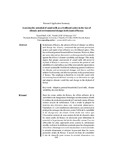| dc.contributor.author | Nyariki, Dickson M. | |
| dc.contributor.author | Yazan Elhadi, A.M. | |
| dc.contributor.author | Wasonga, V.O. | |
| dc.date.accessioned | 2017-02-25T06:23:44Z | |
| dc.date.available | 2017-02-25T06:23:44Z | |
| dc.date.issued | 2012 | |
| dc.identifier.uri | http://hdl.handle.net/123456789/175 | |
| dc.identifier.uri | http://erepository.uonbi.ac.ke/handle/11295/65251 | |
| dc.identifier.uri | https://repository.ruforum.org/documents/assessing-potential-camel-milk-livelihood-option-face-climatic-and-environmental-changes | |
| dc.identifier.uri | http://erepository.uonbi.ac.ke/handle/11295/65251 | |
| dc.description.abstract | In drylands of Kenya, the adverse effects of climate variability and change has directly weakened the pastoral production system and made it less effective as a livelihood option. This has med most pastoral household food insecure. However, there are many alternatives that exist to cushion pastoral households against the effect of climate variability and change. This study argues that proper assessment of camel milk sub-sector in dryland of Kenya is necessary to ascertain the potential and suitability of camel milk as one of the most suitable opportunities to ensure sustainable livelihood; enhancing pastoral resilience for climatic and environmental changes and shocks and thus achieve food security and alleviate poverty in dry pastoral areas of Kenya. The emphasis is therefore to consider camel milk for ensuring household food security as an alternative to cope and adapt to climate variability and change in the dryland of Kenya | en_US |
| dc.language.iso | en | en_US |
| dc.title | Assessing the potential of camel milk as a livelihood option in the face of climatic and environmental changes in drylands of Kenya | en_US |
| dc.type | Article | en_US |

